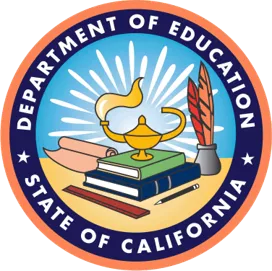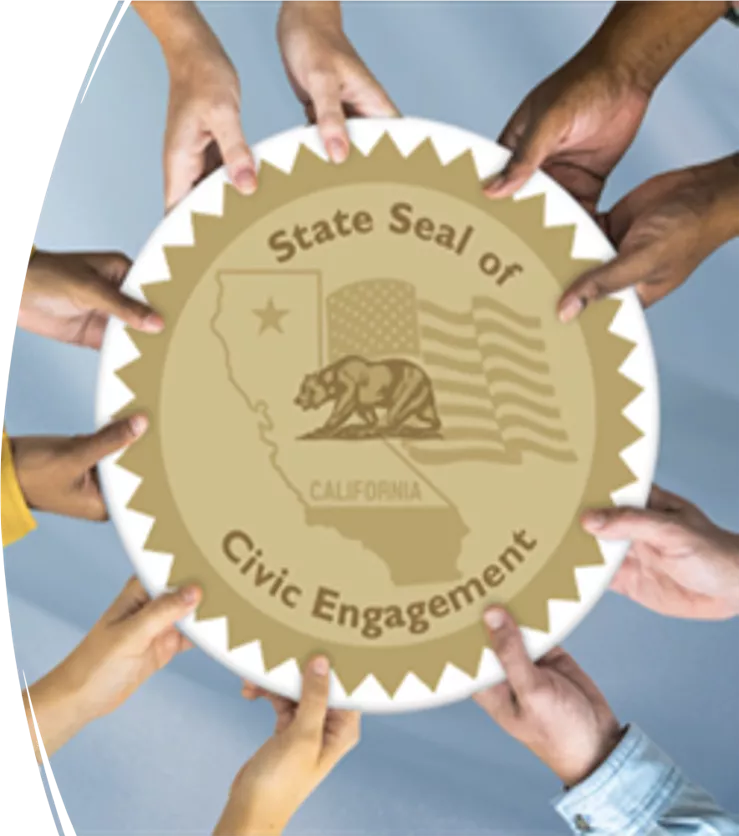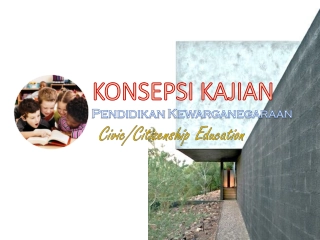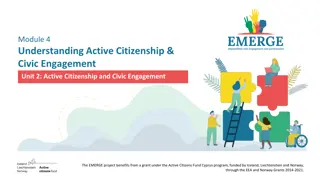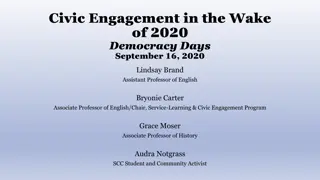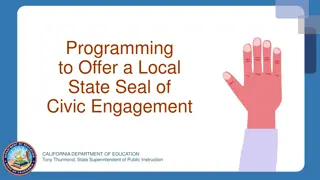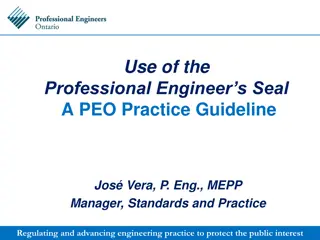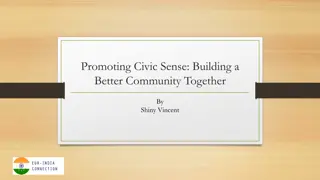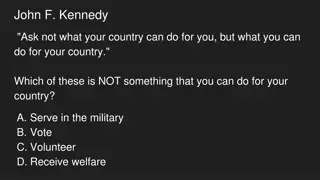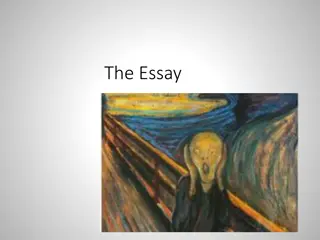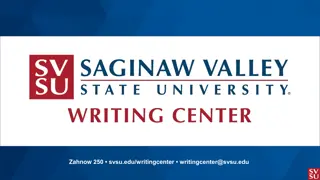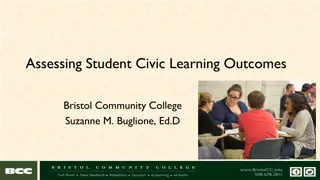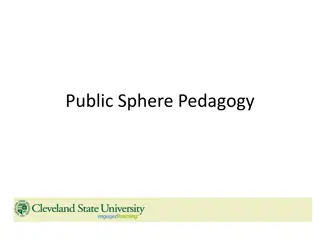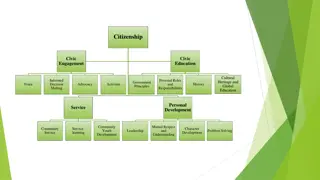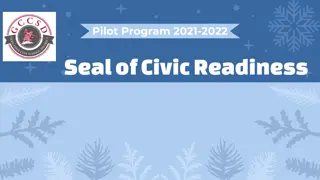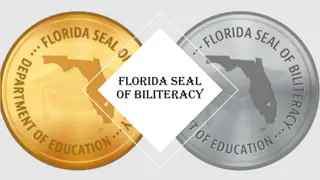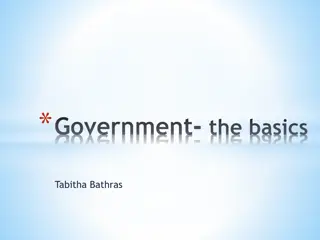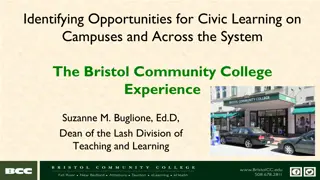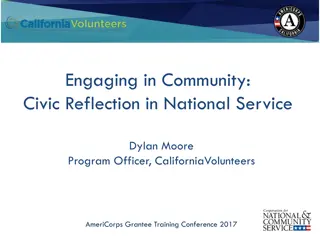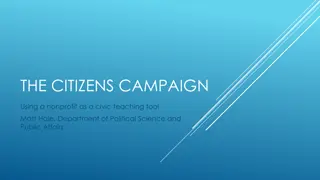Understanding the State Seal of Civic Engagement in California
The State Seal of Civic Engagement (SSCE) is a recognition program for California public school students in grades eleven and twelve who excel in civics education and demonstrate understanding of the US and California constitutions. Established through Assembly Bill 24 to promote civic engagement, students must meet specific criteria to earn the SSCE. Learn about the background, purpose, timeline, and statewide criteria for earning this prestigious recognition.
Download Presentation

Please find below an Image/Link to download the presentation.
The content on the website is provided AS IS for your information and personal use only. It may not be sold, licensed, or shared on other websites without obtaining consent from the author. Download presentation by click this link. If you encounter any issues during the download, it is possible that the publisher has removed the file from their server.
E N D
Presentation Transcript
Getting Started with the State Seal of Civic Engagement CALIFORNIA DEPARTMENT OF EDUCATION Tony Thurmond, State Superintendent of Public Instruction
Slide Notes Slide notes are present throughout this presentation.
What is the State Seal of Civic Engagement?
The State Seal of Civic Engagement The State Seal of Civic Engagement (SSCE) is a recognition conferred by the State Superintendent of Public Instruction for California public school students in grade eleven or twelve who demonstrate excellence in civics education and participation, as well as an understanding of the United States Constitution, the California Constitution, and the democratic system of government. StateSealof CivicEngagement
Background and Purpose Assembly Bill 24 (2017) instructed the California Department of Education (CDE) to develop a set of criteria to recognize students who have demonstrated excellence in civic education. It is the intent of the Legislature to establish a SSCE to encourage, and create pathways for, pupils in elementary and secondary schools to become civically engaged in democratic governmental institutions at the local, state, and national levels. -California Education Code Section 51470
Timeline Date Event AB 24 signed into law. October 2017 Drafting, review, and editing of the SSCE statewide criteria and guidance. November 2018 April 2019 July 2019 Draft criteria presented to the State Board of Education (SBE). Revised draft criteria presented to the SBE. September 2019 Final criteria adopted by the SBE. September 2020 First year of statewide SSCE implementation. 2020 21
What are the criteria for earning a State Seal of Civic Engagement?
Statewide Criteria (1) To earn a SSCE, students must be enrolled in grade eleven or twelve at a participating local educational agency (LEA), and must fulfill each of the following five statewide criteria: 1. Be engaged in academic work in a productive way. 2. Demonstrate a competent understanding of United States and California constitutions; functions and governance of local governments; tribal government structures and organizations; the role of the citizen in a constitutional democracy; and democratic principles, concepts, and processes.
Statewide Criteria (2) The student must: 3. Participate in one or more informed civic engagement project(s) that address real-world problems and require students to identify and inquire into civic needs or problems, consider varied responses, take action, and reflect on efforts. 4. Demonstrate civic knowledge, skills, and dispositions through self-reflection. 5. Exhibit character traits that reflect civic-mindedness and a commitment to positively impact the classroom, school, community and/or society.
Implementation Guidance The Implementation Guidance for each criterion offers ideas, questions, and considerations to structure local requirements to award the SSCE, using the criteria set forward by the CDE as a foundation. The Local Programming presentation on the SSCE web page breaks down criteria with key questions from the implementation guidance.
Who is eligible to earn a State Seal of Civic Engagement?
Student Eligibility- Any grade eleven or grade twelve pupil enrolled in California public schools, direct funded charter schools, the juvenile justice system, and/or in alternative school settings at a participating LEA is eligible to earn a SSCE. The SSCE may only be offered at the LEA level. Individual school sites may not offer the SSCE without it also being available districtwide. Students may not earn an SSCE before grade eleven. However, LEAs are encouraged to develop local means of recognition for younger students as a pathway to earning the SSCE, such as promotion certificates and/or cords.
Eligible Documents Students receive one gold embossed insignia, which may be placed on one document: StateSealof High School Diplomas General Educational Development Certificates Certificates of Completion Transcripts (grades eleven or twelve) A black and white insignia for placement on transcripts in addition to a diploma is not provided. LEAs may choose to develop additional local forms of recognition. CivicEngagement
How is the State Seal of Civic Engagement implemented locally?
Local Guidelines The SSCE is a local opportunity, and the process through which a student earns a SSCE differs from LEA to LEA. Leveraging Equity and Access in Democratic Education (UCLA) published reports that highlight examples of local programs: Breaking New Ground with California s State Seal of Civic Engagement: Lessons from Year 1 (Civic Engagement Research Group) California s Commitment to K 12 Civic Learning: A 2022 Assessment (Civic Engagement Research Group) The Authentic Preparation Today (Civic Seal) working group created resources (Civic Seal) to support LEAs in developing local guidelines.
Sample General Process Create Local Team, Develop Board Resolution, Take Inventory Develop and Adopt Local Criteria Design and Implement Programming Components Request Insignias from the CDE and Distribute to Students
Create Implementation Team (1) Create implementation teams to coordinate development of criteria, policies, and procedures to earn the SSCE: County, district, and site leadership Elementary and secondary educators representing a variety of subjects Students Community representatives and local officials The Civic Engagement Research Group (CERG) Educating 4 Democracy (CERG) team created a SSCE planning packet (CERG) that includes guidance on establishing implementation teams.
Create Implementation Team (2) If possible, include elementary and middle school representatives on implementation teams. The Orange County Department of Education (OCDE), along with the San Diego County Office of Education, created a kindergarten through grade eight (K 8) pathway program wherein participating districts can honor students in grades three, five, and eight: OCDE Civic Learning Pathways K 8 Civic Pathway Program (OCDE) K 8 Pathway Program Timeline (OCDE)
Develop Board Resolution Develop a county, district, or charter site board resolution supporting the statewide SSCE criteria with the intent to design a process for earning the SSCE locally (optional). Consider including Local Control and Accountability Plan language related to civic engagement opportunities. The Los Angeles County Office of Education (LACOE) SSCE Collaborative offers sample governing board resolutions, and many other resources to support local implementation.
Take Inventory Take inventory of the LEA s assets and needs related to civic learning and engagement: What opportunities and community connections already exist? What courses cover civic curriculum or civic projects, and where is there room to infuse this in other subject areas? Who already participates, and what barriers to entry may currently exist? The CERG Educating 4 Democracy SSCE planning packet includes forms and guiding questions to help implementation teams take inventory.
Develop and Adopt Local Criteria In addition to the five statewide criteria adopted by the SBE, LEAs are also encouraged, wherever possible and practical, to develop specific criteria that reflect their local communities and school populations. Local criteria must be aligned to the statewide criteria. This criteria can be crucial in ensuring maximum accessibility for all students, including students in alternative school settings. The Santa Clara County Office of Education SSCE web page includes a variety of resources to support development of accessible local SSCE programs.
Design Requirements and Procedures The LEA will need to develop the local requirements and procedures that students will go through to earn a SSCE: Course enrollment, grade requirements, local assessments Civic engagement project guidelines and procedures Procedures for self-reflection and external recommendations Application and insignia distribution processes Any additional local requirements Sacramento City Unified School District (SCUSD) created local criteria and procedures (SCUSD) for students working towards a SSCE.
Special Considerations Interdisciplinarity Involve other content and disciplines in addition to History Social Science (HSS) Depth Elementary and middle schools Long-term, evolving engagement Accessibility Continuation schools, juvenile justice, low income, special education, English learners, etc.
How do Local Educational Agencies request insignias?
Requesting Insignias The SSCE Insignia Request Form is updated annually and is available by the early spring from the SSCE web page. The participating LEA must submit the SSCE Insignia Request Form; individual sites may not request insignias. Also used to request additional insignias or correct previous requests. No deadline; requests are processed on an ongoing basis. Request insignias from the CDE at least four weeks before they will be affixed to eligible documents and distributed to students.
Insignia Request Form (1) Available from SSCE web page. Information Requested: LEA identification and contact information Number of insignia requested, broken down by eligible document School sites with students receiving insignias
Insignia Request Form (2) Form may be used for new requests, corrected requests, or additional requests. Choose Corrected Request to update total insignias distributed, insignia distribution, or school sites. Choose Additional Request to request additional insignias be sent to the LEA.
Insignia Request Form (3) Enter the total number of insignias requested. Each student receives one insignia. Amounts entered under How many insignias will be affixed to each document type? should equal the total number of insignias requested. Estimate the distribution and correct later, as needed.
Suggested Record Keeping Local criteria and student tracking records Pathway agreements (if applicable) Identified community partners Site staff leads or advisors Summary of evidence submitted by students Student applications Timeline or list of activities Participating students Distribution of those insignias among eligible documents Number of insignias distributed each year Students who did not qualify for an SSCE
Data Reporting (1) CDE captures and reports data provided by LEAs through the Insignia Request Form. Spreadsheets are available dating back to the 2020 21 school year. The CDE publishes this statewide data in a spreadsheet on the SSCE web page each fall. Student names are not collected.
Data Reporting (2) Student-level SSCE data is not currently required through statewide data reporting systems. The CDE is investigating ways to incorporate additional criteria for recognizing civic engagement in the College/Career Indicator. Visit the California Longitudinal Pupil Achievement Data System web page for updates on an ad hoc data collection tool under development to support this work. Background information is available from the SBE Items Related to the SSCE web page.
What additional resources are available?
Additional Civic Awards and Programs LACOE s California Democracy School Awards Civic Learning Initiative s Civic Learning Awards, facilitated by the Power of Democracy Steering Committee Judges in the Classroom
California Department of Education Implementation Resources SSCE Implementation Guidance SSCE Frequently Asked Questions Related SBE Items Resources to Support Civic Engagement California Educators Together SSCE Group
Staying Updated SSCE Inbox SSCE@cde.ca.gov HSS Listserv To join, send a blank email message to join-history-social-science@mlist.cde.ca.gov CDE Twitter/X Accounts HSS: @CaEdHSS Professional Learning: @CaProfLearning CDE: CaDeptEd
Thank you! California Department of Education Professional Learning Support Division SSCE@cde.ca.gov CALIFORNIA DEPARTMENT OF EDUCATION Tony Thurmond, State Superintendent of Public Instruction




